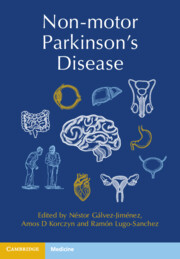Book contents
- Non-Motor Parkinson’s Disease
- Non-Motor Parkinson’s Disease
- Copyright page
- Contents
- Contributors
- Introduction
- Chapter 1 Parkinson’s Disease: An Overview of the Non-Motor Symptomatology
- Chapter 2 Evaluation of the Patient with Parkinson’s Disease in the Early Stages: Non-Motor Phase
- Chapter 3 Non-Motor Symptoms in Late-Stage Parkinson’s Disease
- Chapter 4 Neuropathology of Non-Motor Parkinson’s Disease Symptoms
- Chapter 5 Neuroimaging Studies in Non-Motor Parkinson’s Disease Symptoms
- Chapter 6 Mild Cognitive Impairment
- Chapter 7 Cognitive Dysfunction in Parkinson’s Disease
- Chapter 8 Neuropsychiatric (Behavioral) Symptoms in Parkinson’s Disease
- Chapter 9 Mood Disorders in Parkinson’s Disease
- Chapter 10 Olfactory Dysfunction in Parkinson’s Disease and Related Disorders
- Chapter 11 Oculomotor and Visual-Vestibular Disturbances in Parkinson’s Disease
- Chapter 12 Autonomic Dysfunction and Failure in Parkinson’s Disease
- Chapter 13 Gastrointestinal Disturbances in Parkinson’s Disease Including the Management of Sialorrhea
- Chapter 14 Sexual Dysfunction in Parkinson’s Disease
- Chapter 15 Sleep Disturbances in Parkinson’s Disease
- Chapter 16 Musculoskeletal Disorders and Pain in Parkinson’s Disease
- Chapter 17 Cutaneous Manifestations of Parkinson’s Disease
- Chapter 18 Genetics of Non-Motor Symptoms of Parkinson’s Disease
- Chapter 19 Drug-Induced Non-Motor Symptoms in Parkinson’s Disease
- Chapter 20 Impulse Control Disorders and the Dopamine Dysregulation Syndrome
- Chapter 21 Serotonin Syndrome and Drug Interactions, Hypertensive Complications, and, Adverse Effects of Monoamine Oxidase Inhibitors in Patients with Parkinson’s Disease
- Chapter 22 Parkinson’s Disease and Pregnancy
- Index
- Plate Section (PDF Only)
- References
Chapter 15 - Sleep Disturbances in Parkinson’s Disease
Published online by Cambridge University Press: 05 March 2022
- Non-Motor Parkinson’s Disease
- Non-Motor Parkinson’s Disease
- Copyright page
- Contents
- Contributors
- Introduction
- Chapter 1 Parkinson’s Disease: An Overview of the Non-Motor Symptomatology
- Chapter 2 Evaluation of the Patient with Parkinson’s Disease in the Early Stages: Non-Motor Phase
- Chapter 3 Non-Motor Symptoms in Late-Stage Parkinson’s Disease
- Chapter 4 Neuropathology of Non-Motor Parkinson’s Disease Symptoms
- Chapter 5 Neuroimaging Studies in Non-Motor Parkinson’s Disease Symptoms
- Chapter 6 Mild Cognitive Impairment
- Chapter 7 Cognitive Dysfunction in Parkinson’s Disease
- Chapter 8 Neuropsychiatric (Behavioral) Symptoms in Parkinson’s Disease
- Chapter 9 Mood Disorders in Parkinson’s Disease
- Chapter 10 Olfactory Dysfunction in Parkinson’s Disease and Related Disorders
- Chapter 11 Oculomotor and Visual-Vestibular Disturbances in Parkinson’s Disease
- Chapter 12 Autonomic Dysfunction and Failure in Parkinson’s Disease
- Chapter 13 Gastrointestinal Disturbances in Parkinson’s Disease Including the Management of Sialorrhea
- Chapter 14 Sexual Dysfunction in Parkinson’s Disease
- Chapter 15 Sleep Disturbances in Parkinson’s Disease
- Chapter 16 Musculoskeletal Disorders and Pain in Parkinson’s Disease
- Chapter 17 Cutaneous Manifestations of Parkinson’s Disease
- Chapter 18 Genetics of Non-Motor Symptoms of Parkinson’s Disease
- Chapter 19 Drug-Induced Non-Motor Symptoms in Parkinson’s Disease
- Chapter 20 Impulse Control Disorders and the Dopamine Dysregulation Syndrome
- Chapter 21 Serotonin Syndrome and Drug Interactions, Hypertensive Complications, and, Adverse Effects of Monoamine Oxidase Inhibitors in Patients with Parkinson’s Disease
- Chapter 22 Parkinson’s Disease and Pregnancy
- Index
- Plate Section (PDF Only)
- References
Summary
Non-motor symptoms (NMS) are important features in Parkinson’s disease (PD). Sleep disturbances have a high prevalence among NMS and affect quality of life of PD patients [1]. In this chapter we will describe the most important features of the main sleep disorders encountered in PD.
- Type
- Chapter
- Information
- Non-motor Parkinson's Disease , pp. 167 - 177Publisher: Cambridge University PressPrint publication year: 2022
References
- 1
- Cited by



